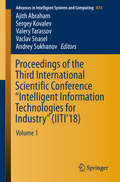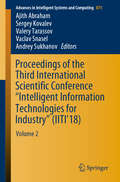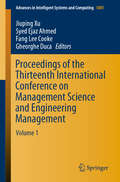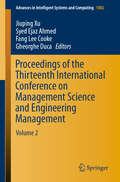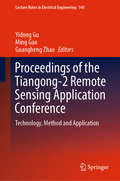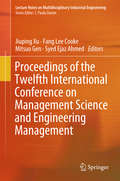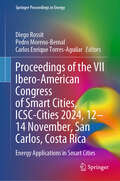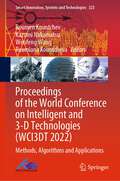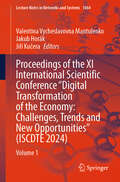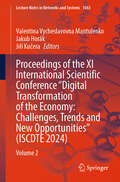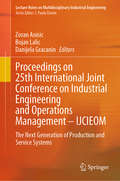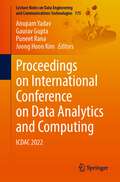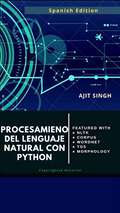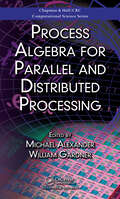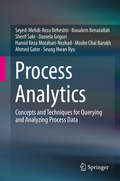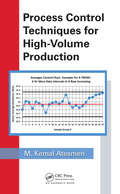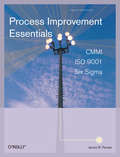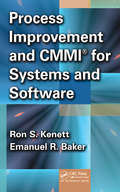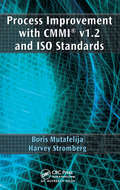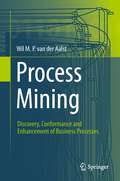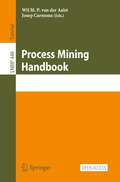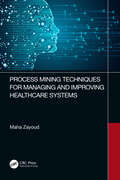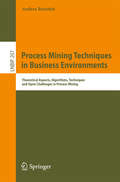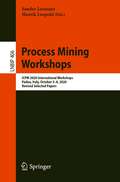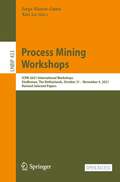- Table View
- List View
Proceedings of the Third International Scientific Conference “Intelligent Information Technologies for Industry”: Volume 1 (Advances in Intelligent Systems and Computing #874)
by Ajith Abraham Vaclav Snasel Sergey Kovalev Valery Tarassov Andrey SukhanovThis book contains papers presented in the main track of IITI 2018, the Third International Scientific Conference on Intelligent Information Technologies for Industry held in Sochi, Russia on September 17–21. The conference was jointly co-organized by Rostov State Transport University (Russia) and VŠB – Technical University of Ostrava (Czech Republic) with the participation of Russian Association for Artificial Intelligence (RAAI). IITI 2018 was devoted to practical models and industrial applications related to intelligent information systems. It was considered as a meeting point for researchers and practitioners to enable the implementation of advanced information technologies into various industries. Nevertheless, some theoretical talks concerning the state-of-the-art in intelligent systems and soft computing were also included into proceedings.
Proceedings of the Third International Scientific Conference “Intelligent Information Technologies for Industry”: Volume 2 (Advances in Intelligent Systems and Computing #875)
by Ajith Abraham Vaclav Snasel Sergey Kovalev Valery Tarassov Andrey SukhanovThis book contains papers presented in the main track of IITI 2018, the Third International Scientific Conference on Intelligent Information Technologies for Industry held in Sochi, Russia on September 17–21. The conference was jointly co-organized by Rostov State Transport University (Russia) and VŠB – Technical University of Ostrava (Czech Republic) with the participation of Russian Association for Artificial Intelligence (RAAI). IITI 2018 was devoted to practical models and industrial applications related to intelligent information systems. It was considered as a meeting point for researchers and practitioners to enable the implementation of advanced information technologies into various industries. Nevertheless, some theoretical talks concerning the state-of-the-art in intelligent systems and soft computing were also included into proceedings.
Proceedings of the Thirteenth International Conference on Management Science and Engineering Management: Volume 1 (Advances in Intelligent Systems and Computing #1001)
by Jiuping Xu Gheorghe Duca Fang Lee Cooke Syed Ejaz AhmedThis book gathers the proceedings of the 13th International Conference on Management Science and Engineering Management (ICMSEM 2019), which was held at Brock University, Ontario, Canada on August 5–8, 2019. Exploring the latest ideas and pioneering research achievements in management science and engineering management, the respective contributions highlight both theoretical and practical studies on management science and computing methodologies, and present advanced management concepts and computing technologies for decision-making problems involving large, uncertain and unstructured data. Accordingly, the proceedings offer researchers and practitioners in related fields an essential update, as well as a source of new research directions.
Proceedings of the Thirteenth International Conference on Management Science and Engineering Management: Volume 2 (Advances in Intelligent Systems and Computing #1002)
by Jiuping Xu Gheorghe Duca Fang Lee Cooke Syed Ejaz AhmedThis book gathers the proceedings of the 13th International Conference on Management Science and Engineering Management (ICMSEM 2019), which was held at Brock University, Ontario, Canada on August 5–8, 2019. Exploring the latest ideas and pioneering research achievements in management science and engineering management, the respective contributions highlight both theoretical and practical studies on management science and computing methodologies, and present advanced management concepts and computing technologies for decision-making problems involving large, uncertain and unstructured data. Accordingly, the proceedings offer researchers and practitioners in related fields an essential update, as well as a source of new research directions.
Proceedings of the Tiangong-2 Remote Sensing Application Conference: Technology, Method and Application (Lecture Notes in Electrical Engineering #541)
by Yidong Gu Ming Gao Guangheng ZhaoThis book gathers a selection of peer-reviewed papers presented at the Tiangong-2 Data Utilization Conference, which was held in Beijing, China, in December 2018. As the first space laboratory in China, Tiangong-2 carries 3 new types of remote sensing payloads – the Wide-band Imaging Spectrometer (WIS), Three-dimensional Imaging Microwave Altimeter (TIMA), and Multi-band Ultraviolet Edge Imaging Spectrometer (MUEIS) – for observing the Earth. The spectrum of the WIS covers 18 bands, from visible to thermal infrared, with a swath of 300km. The TIMA is the first-ever system to use interferometric imaging radar altimeter (InIRA) technology to measure sea surface height and land topography at near-nadir angles with a wide swath. In turn, the MUEIS is the world’s first large-field atmospheric detector capable of quasi-synchronously detecting the characteristics of ultraviolet limb radiation in the middle atmosphere. The Earth observation data obtained by Tiangong-2 has attracted many research groups and been applied in such diverse areas as land resources, water resources, climate change, environmental monitoring, agriculture, forestry, ecology, oceanography, meteorology and so on. The main subjects considered in this proceedings volume include: payload design, data processing, data service and application. It also provides a comprehensive introduction to the research results gleaned by engineers, researchers and scientists throughout the lifecycle of the Tiangong-2 Earth observation data, which will improve the payload development and enhance remote sensing data applications.
Proceedings of the Twelfth International Conference on Management Science and Engineering Management (Lecture Notes on Multidisciplinary Industrial Engineering)
by Jiuping Xu Mitsuo Gen Fang Lee Cooke Syed Ejaz AhmedThis proceedings book is divided in 2 Volumes and 8 Parts. Part I is dedicated to Decision Support System, which is about the information system that supports business or organizational decision-making activities; Part II is on Computing Methodology, which is always used to provide the most effective algorithm for numerical solutions of various modeling problems; Part III presents Information Technology, which is the application of computers to store, study, retrieve, transmit and manipulate data, or information in the context of a business or other enterprise; Part IV is dedicated to Data Analysis, which is a process of inspecting, cleansing, transforming, and modeling data with the goal of discovering useful information, suggesting conclusions, and supporting decision-making; Part V presents papers on Operational Management, which is about the plan, organization, implementation and control of the operation process; Part VI is on Project Management, which is about the initiating, planning, executing, controlling, and closing the work of a team to achieve specific goals and meet specific success criteria at the specified time in the field of engineering; Part VII presents Green Supply Chain, which is about the management of the flow of goods and services based on the concept of “low-carbon”; Part VIII is focused on Industry Strategy Management, which refers to the decision-making and management art of an industry or organization in a long-term and long-term development direction, objectives, tasks and policies, as well as resource allocation.
Proceedings of the VII Ibero-American Congress of Smart Cities, ICSC-Cities 2024, 12–14 November, San Carlos, Costa Rica: Energy Applications in Smart Cities (Springer Proceedings in Energy)
by Diego Rossit Carlos Enrique Torres-Aguilar Pedro Moreno-BernalThis book compiles high-quality selected papers from the VII Ibero-American Congress of Smart Cities (ICSC-CITIES 2024), a leading event in the field of smart urban development. Smart cities are a response to the increasingly urgent need to reorient our lives towards sustainability. In an era of rapid urbanization and growing environmental challenges, these cities are designed to optimize resources, reduce environmental impact, and enhance the overall quality of life for their citizens. By leveraging advanced infrastructure, innovative solutions, and cutting-edge technology, smart cities aim to create more efficient, resilient, and livable urban environments. Within this framework, energy plays a pivotal role in enhancing the sustainability and functionality of our cities. The papers explore a wide range of topics, including smart grids, electric systems, energy efficiency, urban mobility, environmental monitoring, and other areas critical to the development of sustainable cities. The insights and research presented in this book contribute to the ongoing dialogue on how cities can better serve their populations while addressing the challenges of climate change, resource management, and technological integration. ICSC-CITIES 2024 takes place on November 12-14, 2024, in the vibrant city of San Carlos, Costa Rica, and is organized by Tecnológico de Costa Rica (TEC). As the eighth edition of the Ibero-American Congress of Smart Cities, this conference continues to be a key platform for academics, professionals, and policymakers to share knowledge, exchange ideas, and collaborate on the future of urban living. Authors invite the academic community and industry experts to engage in discussions and contribute to shaping the energy-related aspects and overall development of the cities of tomorrow.
Proceedings of the World Conference on Intelligent and 3-D Technologies: Methods, Algorithms and Applications (Smart Innovation, Systems and Technologies #323)
by Kazumi Nakamatsu Roumen Kountchev Wenfeng Wang Roumiana KountchevaThis book features a collection of high-quality, peer-reviewed research papers presented at first ‘World Conference on Intelligent and 3-D Technologies’ (WCI3DT 2022), held in China during May 24–26, 2022. The book provides an opportunity for the researchers and academia as well as practitioners from industry to publish their ideas and recent research development work on all aspects of 3D imaging technologies and artificial intelligence, their applications, and other related areas. The book presents ideas and the works of scientists, engineers, educators, and students from all over the world from institutions and industries.
Proceedings of the XI International Scientific Conference "Digital Transformation of the Economy: Volume 1 (Lecture Notes in Networks and Systems #1064)
by Jakub Horák Valentina Vycheslavovna Mantulenko Jiří KučeraThis book includes selected reports of the XI International Scientific Conference “Digital Transformation of the Economy: Challenges, Trends and New Opportunities” (ISCDTE 2024), Samara, Russia. The proceedings volumes present the latest research on the digital transformation of the economy, its challenges, trends and new opportunities. The conference mainly focused on issues of the digital transformation, such as the theoretical background for the development of socio-economic systems in the digital age and specific practical issues related to actual business practices. Consisting of 8 chapters corresponding to the thematic areas of the conference, and written by scientists and practitioners from different regions, the book offers answers to the most pressing questions for contemporary business, research, engineering and education community from the perspective of the new reality.
Proceedings of the XI International Scientific Conference "Digital Transformation of the Economy: Volume 2 (Lecture Notes in Networks and Systems #1063)
by Jakub Horák Valentina Vycheslavovna Mantulenko Jiří KučeraThis book includes selected reports of the XI International Scientific Conference “Digital Transformation of the Economy: Challenges, Trends and New Opportunities” (ISCDTE 2024), Samara, Russia. The proceedings volumes present the latest research on the digital transformation of the economy, its challenges, trends and new opportunities. The conference mainly focused on issues of the digital transformation, such as the theoretical background for the development of socio-economic systems in the digital age and specific practical issues related to actual business practices. Consisting of 8 chapters corresponding to the thematic areas of the conference, and written by scientists and practitioners from different regions, the book offers answers to the most pressing questions for contemporary business, research, engineering and education community from the perspective of the new reality.
Proceedings on 25th International Joint Conference on Industrial Engineering and Operations Management – IJCIEOM: The Next Generation of Production and Service Systems (Lecture Notes on Multidisciplinary Industrial Engineering)
by Zoran Anisic Bojan Lalic Danijela GracaninThis book presents the conference proceedings of the 25th edition of the International Joint Conference on Industrial Engineering and Operations Management. The conference is organized by 6 institutions (from different countries and continents) that gather a large number of members in the field of operational management, industrial engineering and engineering management. This edition of the conference had the title: THE NEXT GENERATION OF PRODUCTION AND SERVICE SYSTEMS in order to emphasis unpredictable and very changeable future. This conference is aimed to enhance connection between academia and industry and to gather researchers and practitioners specializing in operation management, industrial engineering, engineering management and other related disciplines from around the world.
Proceedings on International Conference on Data Analytics and Computing: ICDAC 2022 (Lecture Notes on Data Engineering and Communications Technologies #175)
by Gaurav Gupta Anupam Yadav Joong Hoon Kim Puneet RanaThis book features selected papers presented at International Conference on Data Analytics and Computing (ICDAC 2022), organized by Department of Mathematics, College of Science and Technology, Wenzhou-Kean University, Wenzhou, China, held during May 28–29, 2022. This book includes state-of-the-art current trends in data science, data analytics optimization, soft computing and related areas. Its primary readers are postgraduate students, researchers and academic professionals.
Procesamient o de Lenguaje Natural con Python: Simplemente en profundidad
by Ajit SinghEste libro tiene como objetivo presentar las técnicas fundamentales del procesamiento del lenguaje natural, desarrollar una comprensión de los límites de esas técnicas y de los temas de investigación actuales, y evaluar algunas aplicaciones actuales y potenciales. ● 1. Introducción. Breve historia de la investigación de la PNL, aplicaciones actuales, arquitectura genérica del sistema de la PNL, enfoques basados en el conocimiento versus enfoques probabilísticos. ●2. Técnicas de estados finitos. En morfología seccional y derivacional, autómatas de estado finito en PNL, transductores de estado finito. ●3. Predicción y etiquetado de partes del discurso. Corpora, DIY Corpus, Corpus Análisis, N-gramas simples, predicción de palabras, etiquetado estocástico y evaluación del rendimiento del sistema. ●4. Análisis y generación. Gramática generativa, gramáticas libres de contexto, parsing y generación con gramáticas libres de contexto, pesos y probabilidades. Gramática basada en restricciones, unificación, semántica compositiva simple. Relaciones semánticas. ●5. PNL con Python
Process Algebra for Parallel and Distributed Processing
by William Gardner Michael AlexanderCollects the Latest Research Involving the Application of Process Algebra to ComputingExploring state-of-the-art applications, Process Algebra for Parallel and Distributed Processing shows how one formal method of reasoning-process algebra-has become a powerful tool for solving design and implementation challenges of concurrent systems. Parallel Pr
Process Analytics
by Seyed-Mehdi-Reza Beheshti Boualem Benatallah Sherif Sakr Daniela Grigori Hamid Reza Motahari-Nezhad Moshe Chai Barukh Ahmed Gater Seung Hwan RyuThis book starts with an introduction to process modeling and process paradigms, then explains how to query and analyze process models, and how to analyze the process execution data. In this way, readers receive a comprehensive overview of what is needed to identify, understand and improve business processes. The book chiefly focuses on concepts, techniques and methods. It covers a large body of knowledge on process analytics - including process data querying, analysis, matching and correlating process data and models - to help practitioners and researchers understand the underlying concepts, problems, methods, tools and techniques involved in modern process analytics. Following an introduction to basic business process and process analytics concepts, it describes the state of the art in this area before examining different analytics techniques in detail. In this regard, the book covers analytics over different levels of process abstractions, from process execution data and methods for linking and correlating process execution data, to inferring process models, querying process execution data and process models, and scalable process data analytics methods. In addition, it provides a review of commercial process analytics tools and their practical applications. The book is intended for a broad readership interested in business process management and process analytics. It provides researchers with an introduction to these fields by comprehensively classifying the current state of research, by describing in-depth techniques and methods, and by highlighting future research directions. Lecturers will find a wealth of material to choose from for a variety of courses, ranging from undergraduate courses in business process management to graduate courses in business process analytics. Lastly, it offers professionals a reference guide to the state of the art in commercial tools and techniques, complemented by many real-world use case scenarios.
Process Control Techniques for High-Volume Production
by M. Kemal AtesmenThis book details most common statistical process control tools with many examples for high-volume production. It aims to make elements of high-volume production process control simple and easy to understand. It lets you thoroughly understand process controls instead of blindly trusting software tools that operate as black boxes. If you are dealing with high-volume production as an operator, line supervisor, inspector, process engineer, quality engineer, manufacturing manager, plant manager, or president of the company, you have to understand the statistical process control basics explained in this book in order to be successful.
Process Improvement Essentials: CMMI, Six Sigma, and ISO 9001
by James R. PersseToday, technology has become too much a part of overall corporate success for its effectiveness to be left to chance. The stakes are too high. Fortunately, the idea of 'quality management' is being reinvigorated. In the last decade process programs have become more and more prevalent. And, out of all the available options, three have moved to the top of the chain. These three are: The 9001:2000 Quality Management Standard from the International Standards Organization;The Capability Maturity Model Integration from the Software Engineering Institute; andSix Sigma, a methodology for improvement shaped by companies such as Motorola, Honeywell, and General Electric. These recognized and proven quality programs are rising in popularity as more technology managers are looking for ways to help remove degrees of risk and uncertainty from their business equations, and to introduce methods of predictability that better ensure success. Process Improvement Essentials combines the foundation needed to understand process improvement theory with the best practices to help individuals implement process improvement initiatives in their organization. The three leading programs: ISO 9001:2000, CMMI, and Six Sigma--amidst the buzz and hype--tend to get lumped together under a common label. This book delivers a combined guide to all three programs, compares their applicability, and then sets the foundation for further exploration. It's a one-stop-shop designed to give you a working orientation to what the field is all about.
Process Improvement and CMMI for Systems and Software
by Ron S. Kenett Emanuel BakerProcess Improvement and CMMI for Systems and Software provides a workable approach for achieving cost-effective process improvements for systems and software. Focusing on planning, implementation, and management in system and software processes, it supplies a brief overview of basic strategic planning models and covers fundamental concepts and appr
Process Improvement with CMMI v1.2 and ISO Standards
by Boris Mutafelija Harvey StrombergIn this age of globalization, process improvement practitioners must be able to comprehend and work with the different standards and frameworks used around the world. While many systems and software engineering organizations rely on a single standard as the primary driver of process improvement efforts (CMMI-based process improvement in the U.S. an
Process Mining
by Wil M. van der AalstThe first to cover this missing link between data mining and process modeling, this book provides real-world techniques for monitoring and analyzing processes in real time. It is a powerful new tool destined to play a key role in business process management.
Process Mining Handbook (Lecture Notes in Business Information Processing #448)
by Wil M. P. van der Aalst Josep CarmonaThis is an open access book. This book comprises all the single courses given as part of the First Summer School on Process Mining, PMSS 2022, which was held in Aachen, Germany, during July 4-8, 2022. This volume contains 17 chapters organized into the following topical sections: Introduction; process discovery; conformance checking; data preprocessing; process enhancement and monitoring; assorted process mining topics; industrial perspective and applications; and closing.
Process Mining Techniques for Managing and Improving Healthcare Systems
by Maha ZayoudThis book discusses a new process mining method along with a detailed comparison between different techniques that provide a complete vision of the process of data acquisition, data analysis, and data prediction. Process Mining Techniques for Managing and Improving Healthcare Systems offers a new framework for process learning which is probabilistic and enables the process to be learned in an accumulative manner. The steps of prediction modeling and building the required knowledge are highlighted throughout the book, along with a strong emphasis on the correlation between the healthcare domain and technology including the different aspects, such as: managing records, information, and procedures; early detection of diseases; and the improvement of accuracy in choosing the right treatment procedures. This reference provides a wealth of knowledge for practitioners, researchers, and students at the basic and intermediary levels working within the healthcare system, computer science, electronics and communications, as well as medical providers and also hospital management entities.
Process Mining Techniques in Business Environments
by Andrea BurattinAfter a brief presentation of the state of the art of process-mining techniques, Andrea Burratin proposes different scenarios for the deployment of process-mining projects, and in particular a characterization of companies in terms of their process awareness. The approaches proposed in this book belong to two different computational paradigms: first to classic "batch process mining," and second to more recent "online process mining. " The book encompasses a revised version of the author's PhD thesis, which won the "Best Process Mining Dissertation Award" in 2014, awarded by the IEEE Task Force on Process Mining.
Process Mining Workshops: ICPM 2020 International Workshops, Padua, Italy, October 5–8, 2020, Revised Selected Papers (Lecture Notes in Business Information Processing #406)
by Henrik Leopold Sander LeemansThis book constitutes revised selected papers from the International Workshops held at the Second International Conference on Process Mining, ICPM 2020, which took place during October 4-9, 2020. The conference was planned to take place in Padua, Italy, but had to be held online due to the COVID-19 pandemic.The conference focuses on the area of process mining research and practice, including theory, algorithmic challenges, and applications. The co-located workshops provided a forum for novel research ideas. The 29 papers included in this volume were carefully reviewed and selected from 59 submissions. They stem from the following workshops: 1st International Workshop on Event Data and Behavioral Analytics (EDBA) 1st International Workshop on Leveraging Machine Learning in Process Mining (ML4PM) 1st International Workshop on Streaming Analytics for Process Mining (SA4PM'20) 5th International Workshop on Process Querying, Manipulation, and Intelligence (PQMI) 3rd International Workshop on Process-Oriented Data Science for Healthcare (PODS4H) 1st International Workshop on Trust and Privacy in Process Analytics (TPPA)
Process Mining Workshops: ICPM 2021 International Workshops, Eindhoven, The Netherlands, October 31 – November 4, 2021, Revised Selected Papers (Lecture Notes in Business Information Processing #433)
by Jorge Munoz-Gama Xixi LuThis open access book constitutes revised selected papers from the International Workshops held at the Third International Conference on Process Mining, ICPM 2021, which took place in Eindhoven, The Netherlands, during October 31–November 4, 2021. The conference focuses on the area of process mining research and practice, including theory, algorithmic challenges, and applications. The co-located workshops provided a forum for novel research ideas. The 28 papers included in this volume were carefully reviewed and selected from 65 submissions. They stem from the following workshops: 2nd International Workshop on Event Data and Behavioral Analytics (EDBA) 2nd International Workshop on Leveraging Machine Learning in Process Mining (ML4PM) 2nd International Workshop on Streaming Analytics for Process Mining (SA4PM) 6th International Workshop on Process Querying, Manipulation, and Intelligence (PQMI) 4th International Workshop on Process-Oriented Data Science for Healthcare (PODS4H) 2nd International Workshop on Trust, Privacy, and Security in Process Analytics (TPSA)One survey paper on the results of the XES 2.0 Workshop is included.
